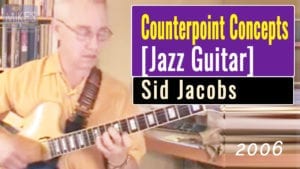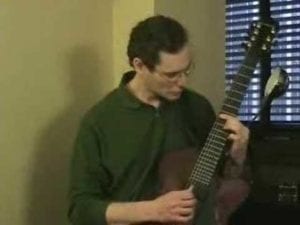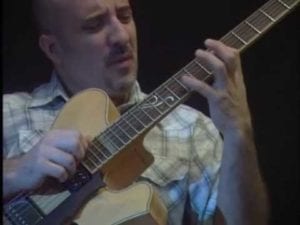Description
Composition + Improvisation = ‘Comprovisation’!
Over the years as a teacher, the question I’ve probably been asked more than any other is: “What can I do to get more vocabulary into my solos?”. Meanwhile, another very common enquiry is: “What’s the most efficient way to go about transcribing?”, which implies a similar sort of overall aim.
Even students who know their theory (and are already engaging in transcription tasks) sometimes express frustrations like “it still doesn’t sound like jazz when I do it” or perhaps “it takes so long for any of it to actually come out in my own playing”. There’s no magic wand, of course, but nevertheless I do think there are ways to speed all this up, so that we can quickly assimilate the sounds we hear, and avoid wasting time. After all, it’s perfectly possible to spend weeks transcribing a long solo, only to look back a year later and realize that virtually nothing has stuck.
The advice I generally give is that, if we want “vocabulary” to appear in our improvised solos, we have to spend time consciously creating it in the practise room. However many scales we know, and however many solos we’ve transcribed, the things we’re hoping to hear aren’t just going to fall out of our instruments. Instead, we may need to think a little bit more like composers, and consider the musical architecture of the ideas we’re going to play; whether these are of our own making, or taken from a recorded source. How is the new phrase structured? How could we develop the idea, and where might it fit in with our existing ones? If it’s someone else’s, how can we make it feel like it’s ours?
None of this is to say that we want our solos to consist entirely of pre-meditated licks or that we shouldn’t aspire to hear spontaneous melodies in the moment of delivery. It’s just that our musical engine needs more specific fuel than a bunch of scales and arpeggios (even the really clever ones) can provide.
In the full 1h15m class:
• We look at nine different melodic ideas from diverse sources such as Oscar Peterson, Joe Henderson, Dizzy Gillespie, and John Coltrane. The ideas reference both mainstream and contemporary styles; some are also taken from famous composed melodies.
• We analyze the structure of each one and consider how it might be expanded beyond its original context.
• Using well-known tunes as “test beds” for the resulting vocabulary, I demonstrate how I might end up employing the ideas, in contexts that may be quite different from the original source.
• A selection of the resulting lines are then transcribed (and tabbed out) in the accompanying PDF booklet.
• Synchronized on-screen captions and timecodes mean that you can always cross-reference between the video and the written materials.
Comprovisation – The Missing Link Class Content | Jamie Taylor
Composition + Improvisation = ‘Comprovisation’!
Over the years as a teacher, the question I’ve probably been asked more than any other is: “What can I do to get more vocabulary into my solos?”. Meanwhile, another very common enquiry is: “What’s the most efficient way to go about transcribing?”, which implies a similar sort of overall aim.
Even students who know their theory (and are already engaging in transcription tasks) sometimes express frustrations like “it still doesn’t sound like jazz when I do it” or perhaps “it takes so long for any of it to actually come out in my own playing”. There’s no magic wand, of course, but nevertheless I do think there are ways to speed all this up, so that we can quickly assimilate the sounds we hear, and avoid wasting time. After all, it’s perfectly possible to spend weeks transcribing a long solo, only to look back a year later and realize that virtually nothing has stuck.
The advice I generally give is that, if we want “vocabulary” to appear in our improvised solos, we have to spend time consciously creating it in the practise room. However many scales we know, and however many solos we’ve transcribed, the things we’re hoping to hear aren’t just going to fall out of our instruments. Instead, we may need to think a little bit more like composers, and consider the musical architecture of the ideas we’re going to play; whether these are of our own making, or taken from a recorded source. How is the new phrase structured? How could we develop the idea, and where might it fit in with our existing ones? If it’s someone else’s, how can we make it feel like it’s ours?
None of this is to say that we want our solos to consist entirely of pre-meditated licks or that we shouldn’t aspire to hear spontaneous melodies in the moment of delivery. It’s just that our musical engine needs more specific fuel than a bunch of scales and arpeggios (even the really clever ones) can provide.
In the full 1h15m class:
• We look at nine different melodic ideas from diverse sources such as Oscar Peterson, Joe Henderson, Dizzy Gillespie, and John Coltrane. The ideas reference both mainstream and contemporary styles; some are also taken from famous composed melodies.
• We analyze the structure of each one and consider how it might be expanded beyond its original context.
• Using well-known tunes as “test beds” for the resulting vocabulary, I demonstrate how I might end up employing the ideas, in contexts that may be quite different from the original source.
• A selection of the resulting lines are then transcribed (and tabbed out) in the accompanying PDF booklet.
• Synchronized on-screen captions and timecodes mean that you can always cross-reference between the video and the written materials.
| Comprovisation – The Missing Link | 01:15:00 |





